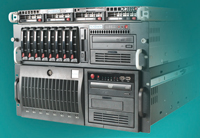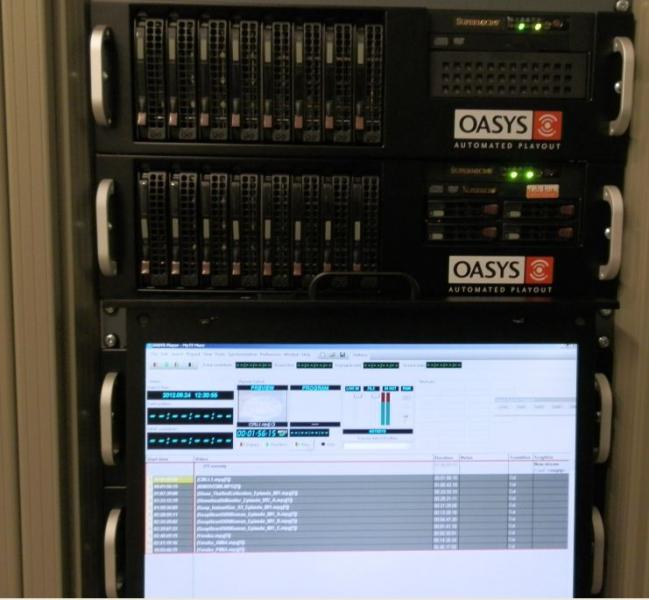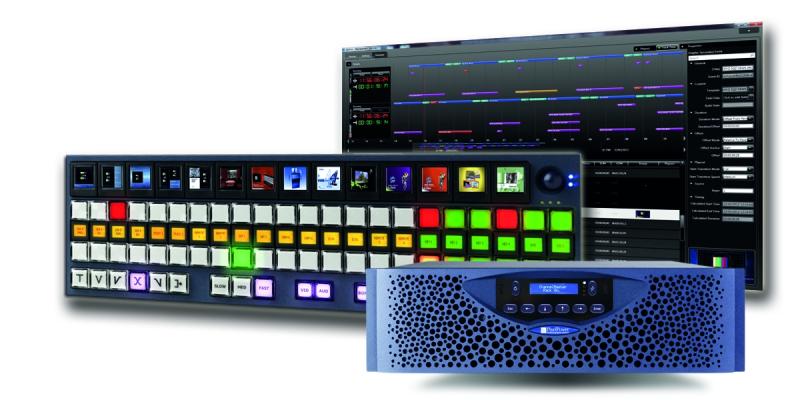Benefits of 'channel-in-a-box' begin to resonate
MULTIPLE CITIES— With increasing regularity, multichannel video operators are experimenting with new ways to deliver programming and launch new channels with the least amount of capital expense and human resources. The current low-margin economics and highly competitive environment dictates it. This has led to the emergence of the channel-in-a-box category: a 1RU or 2RU system that is basically a video server on steroids. They offer the ability to automatically playout preprogrammed clip lists, insert commercials at exactly the right time, add a channel or network ID logos and graphics, and even adjust audio levels.
Another equally important benefit has been to help playout facilities around the world migrate their SD operations to the HD world cost-effectively and add new features easily. Initial concerns about reliability have also been overcome with the latest generation of server technology and software.
The very idea of a small box doing the job of a traditional automation system — costing many times more to install and maintain — was initially met with resistance from many automation system vendors (many of which now themselves offer CIB systems), but as next-generation playout centers and individual “barker” channels began to consider the integrated system technology, the trend could no longer be ignored. Broadcasters and program distributors need more automation capability to run their digital TV channels, they just don’t want to pay a traditional master control operator to do it.
Recognizing the sales potential, today there are more than two-dozen companies that offer some type of automated channel playout device (some traditional server vendors, others new to the category). All provide the benefits of simplified operations with fewer user interfaces for greater efficiencies, reduced rack space and lower power consumption (two critical issues for large playout facilities) and easily expandable functionality.
All of these systems, which address new file-based operations and the need for flexible business models, were on display at the IBC convention in Amsterdam, The Netherlands this month.
PlayBox Technology has been a pioneer in the space, offering one of the first such systems (the "AirBox" IT-based playout automation server) in 1999 and now with 13,200 playout and branding systems installed worldwide. The company’s Channel in a Box product line, which now includes several models including the "EdgeBox," is modular in design, allowing users to customize the system to match a desired workflow. Going well beyond merely selling boxes, the company helps its customers design, install, deliver and support a complete workflow from a single channel playout server to a multi-channel broadcast center. That includes ingest, MAM, traffic, news, playout, storage, scheduling, interactive character generation and graphics, all integrated in a single box.
“Television technology has evolved far and fast in the last years, especially in the area of playout,” said Don Ash, Managing Partner and Director, Sales at Playbox Technology. “Most traditional automation companies have sold out, disappeared altogether or are losing money. The fully integrated features and highly automated operation of the Channel in a Box concept is the reason. A growing community, including tier-one broadcasters, now understand the potential of the technology and want to take advantage of the benefits it offers.”
The professional video industry's #1 source for news, trends and product and tech information. Sign up below.
Those advantages, Ash said, include, easy installation, easy operation, high reliability, easy maintenance, and easy scalability (whether to more channels or to a main-plus-redundant structure.

“The feedback from customers to our Research and Development team keeps PlayBox Technology at the forefront of new technology development.”
At the recent IBC Show Playbox demonstrated an expanded range of playout capabilities across its product line, including a new concept for remote automated playout. The innovative solution facilitates the operation and monitoring of distant broadcast playout channels using the public Internet as the link for all content delivery, control and monitoring.
Repackaging an existing idea
However, is automated playout from an unattended box an innovative new approach? Rush Beesley, president of RushWorks, doesn’t think so. He says his company has offered low-cost, high-performance television production, automation and video streaming systems since 2001. For Beesley, a veteran broadcast engineer and founder of commercial insertion and automation system provider Sundance Digital, automated playout is not a new idea at all.
From 2001 to 2007 RushWorks systems (using software licensed from an overseas vendor) supported from one to four channels of automated playback of MPEG-2 files. The single chassis communicated with routing switchers via serial protocol and supported multiple GPI in and out ports. It also supported one on-screen display or crawl.
Then the company expanded the idea to include full-power broadcasting; LPTV stations, Public, Educational and Government (PEG) channel playback on cable systems, and Internet streaming. They wrote their own software starting in 2006, and rolled out the A-List Broadcast Automation and Streaming System in about a year, along with the complementary VDESK Integrated PTZ Production System for meetings, events and houses of worship. Then they migrated to Matrox OEM cards that support input and output, as well as several layers of graphic compositing that eliminated the need for outboard graphic devices.

“For many years the 'prevailing perception' determined that various automation-related tasks needed to be segregated, running various applications and functions on separate computers, and controlling outboard devices to provide the necessary elements in order for total automation to function,” Beesley said, adding that these disparate tasks included traffic import, file ‘prep,’ automation software, independent playback servers, graphic overlay devices, inventory management systems, and more.
“But technology has evolved exponentially in terms of computing power, memory allocation and management, bus speed, process and thread interaction, and networking capability,” he said. “All this translates into support for multitasking at virtually every level. The keys to integrating all this functionality into a ‘channel in a box,’ as it’s now being called, are fundamentally the combination of (1) appropriate hardware selection and integration, (2) a proper software development environment (generally called the developers’ SDK), and (3) the vision of how to integrate features and functions so that they perform optimally behind a very simple interface that often belies the power and extensibility of the software/hardware solution. This must happen without sacrificing 24/7/365 reliability and operability.”
Like many such systems, the A-List system provides up to four SD/HD channels per chassis and a host of features that include branding, two independent crawls, with configurable font, font size, font color, background color, background transparency, speed, and screen position, a dedicated crawl for EAS, display animated graphic (snipe) with transparency and audio, “Up Next” text overlay, and generic informational text overlay.
Beesley said this aggregated functionality — in a single CIB architecture — translates into a significant price/performance value, with the list price of a single-channel SD system, with two 2TB mirrored drives, at $9,995.
All of the vendors in this space offer the same price performance claims. Broadcast Engineering magazine spoke to several representatives to get their take on the push to keep automation costs low and features and functionality high, in order to support multichannel playout applications, and what these tightly integrated systems mean to the industry’s new technical and economic requirements.
Gaining traction With customers
Florical Systems, based in Gainesville, FL, markets a solution called the Acuitas server. It’s a two-channel, software-centric, fully integrated HD/SD video server based on commodity hardware and a Matrox X.mio2 multichannel HD/SD I/O card that supports 2-D and 3-D graphics, up/down/crossconversion of video, DVEs, EAS integration, software-based switching, and a litany of well-established automation tools. The Acuitas server can function as a standalone box or as a component of a larger multichannel or enterprise system.

Ash Condon, director of sales at Florical Systems, said the technology is steadily “gaining traction” with customers of all types.
“Although this technology is still not widely adopted and in use, it is gaining traction daily,” he said. “A majority of our sales inquiries are about the Acuitas system, and those systems represent a significant percentage of our sales. The popularity of CIAB systems stems from the desire to bring costs of equipment down, both as a capital investment and continuing operational/maintenance costs.”
The business side of television is as competitive as it has ever been, so meeting the demand for high-quality, fully functional systems for a smaller investment appeals to a lot of engineers and decision makers, Condon said.
“When I first started with Florical in 2001, we had two video servers that were the size of refrigerators,” he said. “All they did was encode, store and play video. In the Acuitas world, we have condensed an entire rack full of equipment down to a 2RU chassis.”
Condon said broadcasters are getting more comfortable with the technology than they were in the past (fearing they might get knocked off air at any moment), although it’s still not ubiquitous.
“Although CIB technology is still not widely adopted and in use, it is gaining traction daily,” he said. “A majority of our sales inquiries are about the Acuitas system, and those systems represent a significant percentage of our sales. The popularity of CIAB systems stems from the desire to bring costs of equipment down, both as a capital investment and continuing operational/maintenance costs.”
The business side of television is as competitive as it has ever been, so meeting the demand for high-quality, fully functional systems for a smaller investment appeals to a lot of engineers and decision makers.
“Broadcasting follows the laws of technology in general,” Condon said. “To stay competitive, both as a vendor and as a user, the evolution of broadcast gear must favor smaller multifunction platforms that do more with less — with compelling and measurable return on investments.”
Addressing the need for channel diversification
Grass Valley’s version is a server-based solution called GV Edge. It combines media playout, playlist management, content management, graphics management with channel branding functionality in one tool. Among a list of features, it offers sophisticated graphics tightly integrated with an off-line layout toolset. GV Edge also offers shared media asset management, multilayer 2D and 3G graphics, and is scalable allowing forfast deployment in multichannel environments.

“We have seen significant growth in this space over the past three years due to channel diversification,” said Sam Peterson, director, MPS Product Line, Grass Valley. “With greater channel diversity targeting specific audiences, production environments are looking to reduce capital outlay for new channel deployments.”
The Masstech Group’s CIB product, made in Ontario, Canada, is called Sapphire and is an automation software package integrated into a high-performance server that includes high-capacity hot-swappable storage. Combining Masstech’s PUB-2000 decoder board with Masstech’s own automation software, the system delivers frame-accurate and controlled playout. Masstech Channel in a Box provides multiformat, SD and HD simultaneous playout with automatic up/down converting for back-to-back SD and HD outputs.
The company said that while operators typically have had to ingest files directly into a video server in order to allow the automation system to manage content playout, Masstech’s system is not concerned where content resides, or its format. Instead Masstech storage subsystems deliver content to the CIB server when it requests that content for transmission. The system can also collect content from other storage locations.
“Channel-in-a-box systems are appealing for their simplicity and value,” said Iulian I Ionita, technology evangelist at the Masstech Group. “While there are many variations available, our goal at Masstech has been to provide an elegant solution that delivers a strong core of functionality and ease of use at an exceptional price that cannot be matched by discrete signal chains. We have found a welcoming audience among broadcasters looking for an easily deployed and managed disaster recovery solution.”
He added that CIAB systems are vital part of an operators’ disaster recovery strategy and is now under consideration by a much broader range of media companies. “For some environments, this solution makes a lot of sense and can replace costly automation for some applications. And, what works for DR today certainly provides a strong option for main playout for playout of stored content.”
The traditional broadcast chain in a box
“The market is demanding a more efficient approach to playout,” said Scott Rose, director of Product Management, Miranda Technologies. Miranda offers its iTX platform, which includes playout. The company, however, adamantly prefers not to call its system a channel in a box.
“Broadcasters are accelerating playout technology purchases/installs by bringing them to the forefront of their normal capital replacement cycles,” he said. “This is largely due to the need to reduce operational expenditures by adopting more efficient workflows. By embracing technologies like playlist-aware monitoring, which Miranda offers in iTX, it is now possible to run playout services far more efficiently without compromising quality or service levels.”

Rose said Miranda continues to lead the drive to integrate the traditional broadcast chain into a more compact and efficient process.
“We’ve done just that with iTX, which integrates video server capabilities — including multiformat support, master control effects and live event handling — with proven graphics technology such as our Vertigo XG graphics processor for advanced, data-driven channel branding and promo graphics, and an Adobe After Effects-based iTX Render Service, which automates and manages fully rendered After Effects graphics.”
He added that apart from the obvious benefits of saving space, power and costs, adopting fully integrated playout reduces the pain faced by operators and engineers in dealing with multiple systems from multiple vendors, which often have problems with interoperability. The iTX platform also allows more complex channel graphics and audio configurations to be controlled by an operator within a multichannel environment.
Operational benefits can’t be ignored
UK-based Oasys markets a system called Chameleon, which allows customers to choose the number of inputs and outputs they require in their server (Chameleon supports up to 12 SDI and/or six streaming) and what they will be used for: SD/HD simulcast, ad insertion, time delay, recording, multichannel or as a basic clip player. Chameleon also supports fully branded channels with subtitles, DVEs, scaling, live/file/streaming sources and automatic or manual playlist control.

“As well as cost benefits there are operational benefits,” said Mark Errington, CEO at Oasys. “Simplified redundancy management is a stand out, with failure limited to far fewer pieces of equipment. The functional collapse of features into a single system means that the need for troubleshooting is minimized, fewer physical connections mean less engineering effort and ease of set up means that channels can be launched within days. In addition, CIB systems can be used for disaster recovery purposes and placed at remote sites.”
Some systems like Chameleon are designed to be put to use alongside an existing ingest, scheduling, storage and asset management system. Using such a system means that customers are not locked into a full end-to-end system with one provider, but can benefit from the expertise of a company purely focused on playout.
“The rise in popularity of CIB is largely due to customer demand for more performance from less equipment,” Errington said. “They also want a single point of contact for technical resolution, and the ability to be faster to market with new and improved services appeals to technical decision makers. Meanwhile reduced power consumption, more attractive initial purchase prices and lower total lifecycle costs satisfy the financial heads.”
Avoiding separate operational silos
Pebble Beach Systems, in the UK, offers its Stingray system, which is based upon the company’s Marina and Dolphin automation technology. Stingray is offered as a preconfigured system, but since the control system is based upon Marina, it also offers customers the ability to handle a wide range of channels — from simple clip playback to those that need to cope with late-breaking changes to their schedules.

“The appeal of channel-in-a-box solutions is the assumed cost saving, simplicity of deployment, tight integration between control layer and in built functionality, smaller footprint and lower power consumption per channel,” said Eric Openshaw, General Manager at Pebble Beach Systems. “While these considerations are important we believe customers should consider the bigger picture, especially if they are fitting Channel in a Box solutions around existing infrastructure and workflows. In some cases they will create completely separate operational silos which may lead to inefficiencies and increased cost.”
Pixel Power has its own version of a highly integrated, scalable channel playout system, which it calls ChannelMaster.
The ChannelMaster family of products, which also includes ChannelMaster Clips and ChannelMaster 3D, provides a cost-effective approach to deploying new channels, supporting new channels with a wide range of on-air graphical requirements. The system integrates storage, graphics, DVE, audio, subtitling, master control, live feed and long-form video playout within a single dedicated hardware platform. An integrated master control switcher enables ChannelMaster to meet both automated and live playout requirements. With three live video inputs, ChannelMaster can control an upstream router providing access to an unlimited number of sources. The company said it is also capable of live transitions between sources with preview — a key expectation in live environments.

“Interest is certainly high as everyone is interested in the promises and the potential for cost savings,” said James Gilbert, CEO, Pixel Power. “As the digital tier expands, multichannel operators need to support a variety of channels simultaneously. In some cases, legacy equipment and reduced staffs are not up to the additional workload. For many, the initial equipment costs and manpower requirements associated with traditional workflows are prohibitive. The scenario is becoming even more complex as media companies must deliver their content to new screens such as smartphones, tablets and PCs.”
Innovation Continues
Karl Mehring, senior Product Manager at UK-based Snell (a long-time proponent of integrated playout technology), said that with less complexity and fewer devices to manage in the operation, CIB systems often result in lower installation costs (there’s is less wiring to contend with, which translates into fewer points of failure). Service costs are reduced because there are fewer equipment vendors involved and fewer systems to integrate. Running costs are lower because fewer boxes mean reduced power consumption, reduced space and cooling requirements, and lower maintenance costs. Added to this is speed of deployment of new services, which is an order of magnitude less with a CIAB system.
Snell’s CIB system is called ICE. It features the flexibility to assign elements of an internal broadcast chain in any order to achieve a multitude of presentation styles on the fly. Internally, ICE has numerous assignable mixers that simplify the management of mix effects, graphics, DSKs and audio overs.
“More of today’s consumers expect to view content when and where it’s convenient and on the device of their choosing,” Mehring said. “These market dynamics are forcing broadcasters to offer a broader range of services without a commensurate increase in revenue per service to finance the supporting infrastructure. Out of these requirements has emerged the concept of a “channel in a box,” a turnkey broadcast production system that combines master control and playout functions into a single, compact unit. By reducing the number of complex, high-maintenance systems in a production workflow, a CIB solution offers great potential for helping broadcasters run a leaner and more nimble operation.”
What’s clear is that these tightly integrated playout server systems will continue to improve and embrace the latest that technology has to offer. RushWorks’ Rush Beesley said he’s seen it all before and expects to see even further innovation going forward, for the benefit of the customer.
“So now it’s called ‘channel in a box,’ but with the current vertical rate of acceleration in technology at all levels, it’s likely we’ll be discussing a ‘channel on a chip’ before you know it,” he said.
Editor’s Note: Other companies set to exhibit CIB systems at IBC 2013 include Evertz (“OvertureRT LIVE”), Cinegy ("Cinegy Air"), Harmonic ("Spectrum ChannelPort") and Harris Broadcast (“Versio”).
